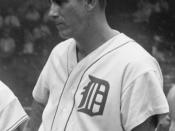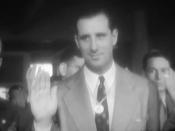Baseball was considered the American game, played by real, true blooded Americans. Prior to the 1930s, the game was almost completely subjugated by the American ethnicity of White Anglo-Saxon Protestants, or WASP. There was an invisible barrier put around the game of Organized Baseball, to keep the other 'inferior' ethnicities from joining in. For years, only true 'whites' could play the game, ball players with other ethnicities would be faced with stereotyping by sport commentators and the Press. The efforts and achievements of two great ball players, Joe DiMaggio and Hank Greenberg, gave everyone a hero that they could look up to, and made it clear that baseball greatness goes beyond just ethnicity.
In the early years, it would seem baseball games were following the rules of the Melting Pot theory. The theory was intentionally designed to be used on the country of America as a whole. The theory treated the country as a giant pot, on a giant stove.
Each ethnicity would be added in, in certain amounts. In the end, each of the distinctive characteristics of the ethnic groups would eventually disappear with time, and the 'brew' would be full of ingredients that would be indistinguishable from each other. However, two important concerns were present. It was important to monitor what ethnicity was added in, as much as the capacity of mixture to absorb those ingredients. This was how discussion of baseball was based on.
For around the first 3 decades of the 20th century, ethnicity of baseball players was deemed relevant and was the basis for commentators. Two ethnic groups received the severest of the commentary attacks, the Jewish and the Italians, until the 1940s, when ethnicity lost priority gradually, until it was barely commented on at all. Two Hall of Famers, Joe DiMaggio and Hank...


